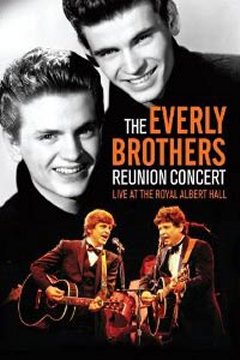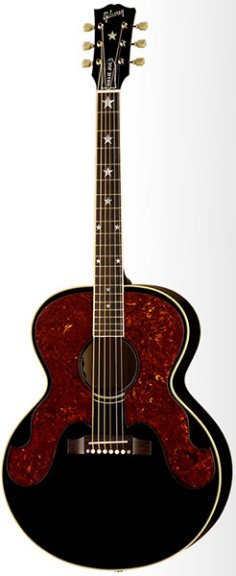Beauty is, of course, in the eye of the beholder. But many
believe the J-180 to be the most gorgeous Gibson acoustic guitar you can
buy. It offers maximum tone, maximum pickguard and a super-curvy shape.
For a history of the J-180 plus close relations to the J-185 and the coveted
Everly Brothers signature models, read on…
 1. The roots of
the J-180 lie in the J-185. The J-185 was introduced by Gibson in 1951,
intending to offer something in-between the dreadnought J-45 and the fabled
Super Jumbo J-200.
1. The roots of
the J-180 lie in the J-185. The J-185 was introduced by Gibson in 1951,
intending to offer something in-between the dreadnought J-45 and the fabled
Super Jumbo J-200.
2. The subtle size-reduction made a difference to many players. The
J-185’s 16-inch jumbo body shape was 1-inch narrower than a J-200, and
was 20 ¼-inches long (the J-200 is 21-inches).
3. The first J-185 guitars were built for only eight years, until 1959.
The J-185 featured figured maple back and sides, a spruce top, two Maltese
cross inlays on the bridge, a 19-fret rosewood fingerboard with double
parallelogram inlays, a mahogany neck, binding on body and neck, Kluson
tuners and a choice of natural or sunburst finishes.
4. But then came the Everly Brothers. Don and Phil hit it big from 1957
with "Bye Bye Love,” “Wake Up Little Susie" and "I Wonder if I Care as
Much," mostly played on larger Gibson J-200s.
Gibson approached the young stars about a signature acoustic, and the
Gibson Everly Brothers signature acoustic was born… now commonly known
as the J-180.
5. The Gibson Everly Brothers flattop featured a thin J-185-style body
and an adjustable bridge. But it also featured five-point star inlays on
the rosewood fretboard and a double tortoiseshell pickguard, which covered
most of the top of the body. The standard finish on the guitar was black,
though a few models were natural or sunburst finish.
6. Don Everly devised the double tail-fin pickguards that extended below
the bridge, to protect the top from his vigorous strumming.
7. The bridge on the Everly Brothers was actually designed by father
Ike Everly, at the suggestion of Phil, a perpetual string breaker. (Ike
Everly reputedly taught Merle Travis the fingerpicking guitar style for
which he became famous.)
8. The bridge was also an ‘oversized’ rosewood design and pinless -
the strings ran through the bridge instead of using bridge pins. Phil’s
string-snapping habit would ultimately lead to his 1995 formation of the
Everly
Music Co., a business dedicated to the production of long-lasting strings.
9. From 1962 to 1971, only 488 Everly Brothers models were made. Depending
on condition, sale value of one of these can reach $15,000.
10. Albert Lee is now the owner of Don Everly's original Everly Brothers
model. The English session guitarist was Musical Director on the duo's
1983 reunion concert at London's Royal Albert Hall, and Lee was presented
with the guitar by Don Everly himself.
 11. Elvis Presley
was the owner of a late '60s Everly Brothers guitar, but one with a natural
finish and with only one pickguard. Auctioned by George Gruhn guitars for
$25,000 in the 1990s, it was previously in the possession of Elvis expert
Jim Curtin, who was given the instrument by Vernon Presley, Elvis's father,
in 1975 in appreciation for another guitar Curtin had made for Elvis. Curtin
said that he was at a jam session at Graceland in 1968 unbelievably, Elvis
didn't have a guitar. So, Elvis sent an aide out to buy a new Gibson Everly
Brothers. Elvis used it at Graceland through 1969.
11. Elvis Presley
was the owner of a late '60s Everly Brothers guitar, but one with a natural
finish and with only one pickguard. Auctioned by George Gruhn guitars for
$25,000 in the 1990s, it was previously in the possession of Elvis expert
Jim Curtin, who was given the instrument by Vernon Presley, Elvis's father,
in 1975 in appreciation for another guitar Curtin had made for Elvis. Curtin
said that he was at a jam session at Graceland in 1968 unbelievably, Elvis
didn't have a guitar. So, Elvis sent an aide out to buy a new Gibson Everly
Brothers. Elvis used it at Graceland through 1969.
12. Jimmy Page owns an early black 1962 Gibson Everly Brothers, but
he says he has never played it on a recording or live - it is just for
home use.
13. The Everly Brothers model was reissued by Gibson in 1986 under the
name J-180. In 1992 it was again designated The Everly Brothers guitar
until 1994 when the name went back to the J-180.
14. Serial numbers will give you an exact year of manufacture, of course,
but as a rough guide, 1960s Everly Brothers signatures with tortoiseshell
pickguards are pre-'68. Black pickguard models are from ’68 onwards.
15. Rarity time! The Gibson Dwight Yoakam Y2K was a limited run of 100
produced in honor of the country star in 1999. It is essentially a combination
of the J-180, with its smaller body and double pickguards, and the J-200
(‘mustache’ bridge, crown inlays and figured maple back and sides).
16. Paul McCartney, Bob Dylan, Neil Diamond, Cat Stevens, Roger Daltrey
and even Madonna have played an Everly Brothers J-180 live.
17. The Billie Joe Armstrong J-180 is the latest version of this legendary
guitar. The Green Day leader has always favored Gibson acoustics, and his
signature model is sumptuous indeed. It features a modified V-profile neck
to Armstrong’s specifications.
18. The Billie Joe Armstrong J-180 also adds a Fishman Matrix VT preamp
and piezo pickup system; an under-saddle acoustic pickup along with active
volume and tone controls in a soundhole-edge-mounted preamp. It also has
a traditional pin bridge.
19. Gibson’s J-180s (and many other acoustics) are made in the company’s
Bozeman, Montana, facility.
20. Back to The Everly Brothers, who made the J-180 legendary. Keith
Richards told Guitar Player magazine that the bro’s were a key influence.
“I realized that one of the best rhythm guitarists in the world ever is
Don Everly, who always used open tuning. Don is the killer rhythm man…
the Everly Brothers stuff was so hard, because it was all on acoustic.”

 1. The roots of
the J-180 lie in the J-185. The J-185 was introduced by Gibson in 1951,
intending to offer something in-between the dreadnought J-45 and the fabled
Super Jumbo J-200.
1. The roots of
the J-180 lie in the J-185. The J-185 was introduced by Gibson in 1951,
intending to offer something in-between the dreadnought J-45 and the fabled
Super Jumbo J-200.
 11. Elvis Presley
was the owner of a late '60s Everly Brothers guitar, but one with a natural
finish and with only one pickguard. Auctioned by George Gruhn guitars for
$25,000 in the 1990s, it was previously in the possession of Elvis expert
Jim Curtin, who was given the instrument by Vernon Presley, Elvis's father,
in 1975 in appreciation for another guitar Curtin had made for Elvis. Curtin
said that he was at a jam session at Graceland in 1968 unbelievably, Elvis
didn't have a guitar. So, Elvis sent an aide out to buy a new Gibson Everly
Brothers. Elvis used it at Graceland through 1969.
11. Elvis Presley
was the owner of a late '60s Everly Brothers guitar, but one with a natural
finish and with only one pickguard. Auctioned by George Gruhn guitars for
$25,000 in the 1990s, it was previously in the possession of Elvis expert
Jim Curtin, who was given the instrument by Vernon Presley, Elvis's father,
in 1975 in appreciation for another guitar Curtin had made for Elvis. Curtin
said that he was at a jam session at Graceland in 1968 unbelievably, Elvis
didn't have a guitar. So, Elvis sent an aide out to buy a new Gibson Everly
Brothers. Elvis used it at Graceland through 1969.